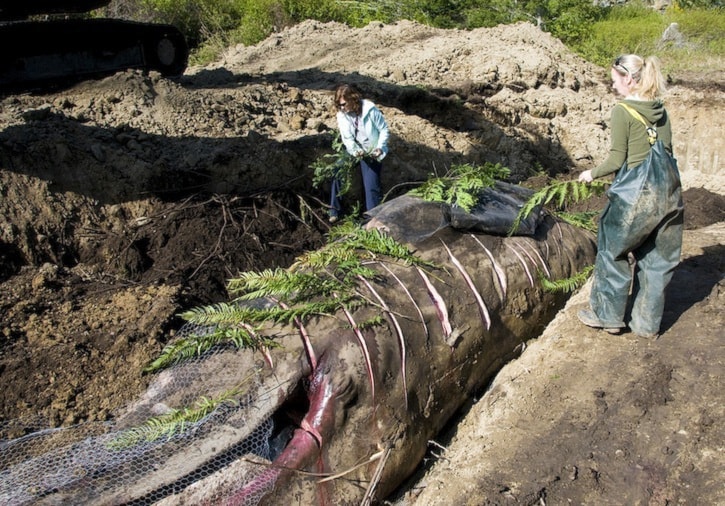Scores of people came to stare at the dead 20-tonne grey whale that had washed up on the shores of East Sooke. People lined up to take photos, they poked at it and dogs sniffed it. Curious yes, but disrespectful.
That was in 2010 and at that time, the Scia’new Nation (Beecher Band) made the decision to bury the large marine mammal on their land, as a sign of respect and also in the hope that it could one day be a teaching tool. Scia’new First Nations member Sharon Cooper initiated the effort to have the whale’s carcass handled with dignity.
With the help of Fisheries and Oceans Canada (DFO) and the Vancouver Island University’s Deep Bay Field Station they buried the carcass. It’s been there for four years and the time is approaching when it will be exhumed and prepared for display. The skeleton will be displayed at the Deep Bay Field Station north of Nanaimo.
“The grey whale from East Sooke will be hung in the center,” said biologist and manager of the field station Brian Kingzett. It will be the highlight of the station’s education program.
Kingzett said a consultant from Salt Spring Island will be leading the project of cleaning and preparing the bones for reassembly.
The process of articulating is a lengthy one, as experienced by a great whale that was hung from the rafters at Edward Milne community school back in 1996. This carcass has been submerged in water in Sooke Basin in 1989 and the marine life picked away at the bones for a year. In 1996 a paleontologist put it all back together.
To get the East Sooke grey whale to the field station will require about $75,000 and UVI has launched a campaign to get people to Buy-A-Bone to help build the whale. There are 145 bones available for purchase and donors will receive a “Bone Ownership” certificate, invitation to the exhibit preview party and a tax deductible receipt for donations over $20. Bone adopters can choose from the name of the whale to the skull, vertebrae, ribs or even the humerus bones. To support this project contact David Forrester at 250-740-6214 or david.forrester@viu.ca.
Grey whales, said Kingzett have come back from near extinction. He said there are now 24,000 and they have the longest migration of any mammal and they go along shallow waters, where they are often spotted by whale watching boats. The UVI News states, “The grey whale is unique as a species in that it feeds in shallow bays and estuaries including foraging in muddy and sandy bottoms for worms, shrimp and other shellfish. During their annual migration from the arctic to the Baja Mexico they travel along the shore of Mexico, the US and British Columbia in very close proximity to where coastal development is occurring.”
To follow the progress of The Whale Project visit Brian Kingzett’s blog at http://viudeepbay.com/2013/04/12/grey-whale-project-ready-for-next-phase/.
For more information, to volunteer or sponsor a bone contact the Deep Bay Marine Field Station at 250-740-6399.
